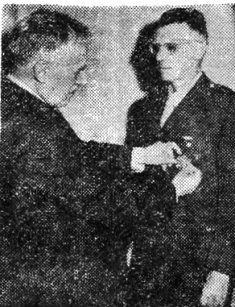|
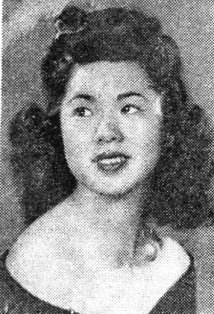 A Nisei sergeant in the India-Burma Theater sent in this pinup of Merle Akutagawa of Salt Lake City.
He says that our Japanese pinup girls of two weeks ago were pretty sad cases and that this should prove a contrast.
He adds that Merle's figure is as pretty as her face.
A Nisei sergeant in the India-Burma Theater sent in this pinup of Merle Akutagawa of Salt Lake City.
He says that our Japanese pinup girls of two weeks ago were pretty sad cases and that this should prove a contrast.
He adds that Merle's figure is as pretty as her face.
|
India-Burma Theater
Birthday 'Historical'
Says Sultan
"The most remarkable military adventure ever embarked upon by troops of the U.S." That was how Lt. Gen. Dan I. Sultan, India-Burma Theater commander summed up the history of the U.S. Forces in the Orient, as the India-Burma and China Theaters
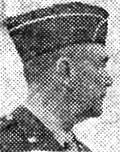
|
Speaking on the anniversary, Sultan declared the results of the battles of Northern and Central Burma have marked the first major defeat to overtake the Japanese armies in continental Asia since fighting was started eight years ago.
"This first big licking of the Japanese is more than a military victory," stated Sultan. "It is the visible ind inescapable sign of an American promise fulfilled. Gen. Joseph W. Stilwell's promise to break the land blockade of China has now been redeemed.
"Because of the distance from home bases of supply, the difficulty of terrain, plus the savage fighting, these remote campaigns will make a place of their own in our military history," Sultan concluded.
It was on March 4, 1942, that the China-Burma-India Theater was proclaimed for U.S. forces under the command of Lt. Gen. Joseph W. Stilwell.
SOS Volunteers May Request Convoy Duty
Volunteers in Services of Supply, India-Burma Theater, can now apply to their commanding officers for permission to drive convoys to China over the new Stilwell Highway, it was stated this week by Lt. Col. Allen C. Bigelow, chief of the Transportation Section, Transportation Service, SOS.
Bigelow says SOS needs men to drive the supply convoys to Kunming with the initial deliveries scheduled this month. He urges men desirous of volunteering to see their commanding officers without delay.
After arrival in Kunming the drivers will be flown back to India-Burma Theater. Volunteers must be experienced drivers of vehicles having a capacity of two and a half tons or more. The selectees will be given a 15-day refresher course and then will be examined by the cadre men of Brig. Gen. Lewis A. Pick's Motor Transport Service at Advance Section No. 3, SOS, where the convoys are assembled.
It is planned to send out separate convoys manned chiefly by men and officers from the same organization. Bigelow stated that the men will be under jurisdiction of the India-Burma Services of Supply Forces even when they are in China.
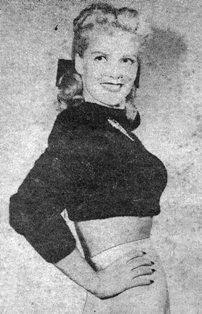 Sweaters are shrinking back in the States. Every year they wear less and less. When we get home in 1960, we will be
able to use that 20-20 vision on something like this. Janice Carter shows the 1945 fashion in the States with bare
midriffs predominating.
Sweaters are shrinking back in the States. Every year they wear less and less. When we get home in 1960, we will be
able to use that 20-20 vision on something like this. Janice Carter shows the 1945 fashion in the States with bare
midriffs predominating.
|
Jack Nolan, Ex-Roundup Cartoonist,
Receives Legion Of Merit Award
NEW YORK (UP) - The award of the Legion of Merit has been made to Pfc. Jack Nolan, former cartoonist with the I-B Roundup, Army newspaper in the India-Burma Theater, it was announced this week by Second Corps Area command.

|
Nolan, 25, received the decoration for his work on the paper, for a hanbook on jungle warfare, and for posters warning about malaria and venereal disease. He is now on the staff of Newsmap, Army orientation activity with the Information and Education Division in New York City.
Bronx-born Jack Nolan is best known for his cartoon creation, "Cpl. G.I.," a bug-eyed little trouble-maker who first appeared on the bulletin board of the troopship Brazil during a monotonous two months' voyage to India in early 1942. "G.I." dramatized daily the numerous ahipboard gripes of the troops.
When Lt. Col. (then Capt.) Fred Eldridge, Gen. Joseph Stilwell's public relations officer, had Nolan transferred from a desert station to a job on the original Roundup staff in September 1942, "Cpl. G.I." was received becoming the most popular feature in the paper.
Before receiving his "greeting" in October, 1941, Nolan had attended New York Industrial high school, where he began his drawing career, and worked for Max Fleisher and later, Paul Terry's Terrytoons.
He departed from the CBI Theater in April 1944, on rotation, returning to New York City where he married Miss Margaret O'Mara soon after being reassigned. The couple now live at 221 Seaman Avenue in New York.
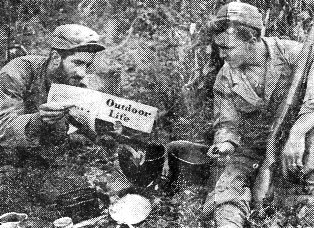 Cpl. Harry McMullen, left, of Council Bluff, Iowa, and Cpl. Bernard Weston, Griswold, Iowa, had just completed
three months of jungle marching and fighting with the Mars Task Force. They looked forward to some good reading about
indoor sport when some literature was air-dropped. Look what they got - Outdoor Life. And there weren't any
hints about how to use the Jap mess gear (foreground) for American cooking.
Cpl. Harry McMullen, left, of Council Bluff, Iowa, and Cpl. Bernard Weston, Griswold, Iowa, had just completed
three months of jungle marching and fighting with the Mars Task Force. They looked forward to some good reading about
indoor sport when some literature was air-dropped. Look what they got - Outdoor Life. And there weren't any
hints about how to use the Jap mess gear (foreground) for American cooking.
|
EAC Liberators Fly 2,500 Miles
To Blast Korat
HQ., EASTERN AIR COMMAND - EAC Liberators made a 2,500-mile round-trip flight to blast Japanese railway yards and repair shops at Korat, Siam, this week, causing many explosions and huge fires, as Eastern Air Command aircraft continued their relentless aerial assaults against the enemy.
Other B-24's of the USAAF concentrated on Mingaladon, near Rangoon, dropping thousands of fragmentation bombs on the important Nip airbase.
Chief activities of EAC, however, were raids on enemy communications and supporting attacks for the Allied ground troops in the Mandalay area. Mahlaing and Myinmu, only 50 miles east of the 14th Army's bridgehead across the Irrawaddy River, were plastered with more than 200 tons of explosives by heavy bombers. Another 200 tons of bombs were dropped on the enemy railhead at Myingyan, vital reinforcement line from Thazi to the Irrawaddy. Jap stores and troops at Taunggyi, southeast of Mandalay, were hit by 175 tons of bombs.
Smaller EAC aircraft, fighters and fighter-bombers, carried out many destructive blows during the week at enemy supply dumps and troop concentrations.
Super-Forts of Brig. Gen. R. M. Ramey's XX Bomber Command made a successful sweep over Jap-held Singapore this week, with good results reported. One B-29 was lost in this raid.
73 Pct. Of Pay Sent To U.S.
Seventy-three cents out of each pay dollar of the USAAF in the India-Burma Theater goes back to the States either for the family of the individual soldier or for bank deposit, according to figures released this week by Col. John H. Doherty, Air Corps Finance Officer. Allotments of pay account for 48 cents of each dollar. The balance is divided between expenses in India and further transfer to someone back home. The additional transmittal of pay accounts for another 25 cents of each pay dollar. Payments are forwarded through official channels such as money orders, Army Post Exchange sales, soldiers deposits, and personal transfer of funds for transmittal to the U.S. All that remains for spending in India and Burma is 27 cents out of each dollar.
 The boys of the veteran Seventh Bombardment Group were very impolite to this Burma-Siam Railroad bridge at
Kanchanaburi, about 75 miles west of Bangkok. The concrete pier supporting the spans was destroyed in a low level attack last month. The bridge was on an important supply route for the Nips and considerable ack-ack was encountered.
The boys of the veteran Seventh Bombardment Group were very impolite to this Burma-Siam Railroad bridge at
Kanchanaburi, about 75 miles west of Bangkok. The concrete pier supporting the spans was destroyed in a low level attack last month. The bridge was on an important supply route for the Nips and considerable ack-ack was encountered.
|
LASHIO UNDER ATTACK
BY CHINESE COLUMNS
GEN. SULTAN'S HQ., NORTH BURMA - The Japanese Burma Road base of Lashio is under direct frontal assault by troops of the Chinese First Army of Lt. Gen. Dan I. Sultan's Northern Combat Area Command this week as two other Chinese columns converged on the city from the east and west.
The Chinese attacking from the north were placed at six and a half miles from the Nip bastion. A flanking force had broken the enemy stand 12 miles east as the third element swung in eight miles west of Lashio.
Precision bombing by planes of the 10th Air Force had destroyed the last of the six major bridges in the area, making retreat out of Lashio difficult.
In their southward drive the Chinese cleared the Namtu-Hsipaw Road as far as Man Sam. Other troops, moving south on the Man Sam Road captured Panghkyem, hub on the all-weather route that runs through the Hsipaw-Lashio-Namtu area. One all-weather road runs south to Hsipaw, another east to Lashio. Panghkyem is on the Man Sam-Lashio Road, 22 road miles east of Lashio.
After the surprise crossing of the Namtu River by the Chinese and heavy fighting in that area for several days the enemy apparently withdrew, leaving only delaying parties.
The Chinese troops driving from the north linked up leading elements for a combined assault on the town.
New Foothold Near Mandalay
BURMA - British 14th Army troops of the Second Division have established a new bridgehead in the Mandalay area, this time in the vicinity of Ngazun, 31 miles west of Mandalay.
This bridgehead is the nearest one to the city and is just eight miles east of the Myinmu bridgehead of the 20th Indian Division.
The british now have five bridgeheads across the Irrawaddy and are continuing their pincer movement on the city. The Nips threw in strong counter-attacks in the Myinmu-Talingon area during the week, which were repulsed. The British are pushing south and east from their Singu bridgehead.
During the week B-25's of the 12th Bombardment Group, EAC, gave Mandalay a severe shellacking, marking the first raid on the Burma city by this veteran American bomber group.
Other 14th Army units pushed 85 miles eastward from their Pakokku bridgehead to capture to Meiktila airfields. Airborne forces followed up by landing on the fields. Fighting is continuing in the area.
CHINESE RECOVER SUICHWAN FIELD
CHUNGKING (ANS) - A Chinese communique this week announced the recapture of the former American airbase town of Suichwan in Western Kwangsi province, which was blown up and abandoned several weeks ago.
The Chinese said enemy attacks on the town had again been thrown back.
Fourteenth Air Force communiques, meanwhile, reported the sinking of five ocean-going vessels in the South China Sea by B-24's, with three other ships, including two large tankers, probably sunk and two more damaged.
Fighters ranging from the Yellow River to Indo-China destroyed 51 trucks and damaged 90 others in the Siang and Lung Valleys, and also destroyed three Jap bombers on the ground during the week's operations.
G.I. PRAYER
CLEVELAND (ANS) - Gen. Joseph Stilwell, new Army Ground Forces chief, spoke up for the infantry this week when he told the Cleveland Ordnance Association that more attention should be paid to the "lads who are carrying the ball."
"These are the sluggers who are at it all the time, day and night in all weather," said Stilwell. "These are the troops that get the decisions: if they get forward we win, if they are forced back we lose."
Gen. Stilwell said the average G.I. was intelligent and remains a realist, which explains his daily prayer: "Oh Lord, distribute the bullets as you do the pay - let the officers get most of them."
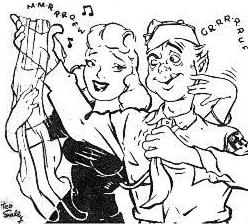
|
TOLD BY I-B SCRIBE
By S/SGT. KARL PETERSON
(Safely returned from a hectic 30-day tour of "bommerang rotation" in a far-off land and now happily embarked on his fourth year in India, the Roundup's indoor sports editor, S/Sgt. Karl Peterson, reports on life in America as seen through his bloodshot eyes. - Editor)
It is embarassing that this version of "The Return of the native" can not begin with the customary description of emotions at seeing the Statue of Liberty in New York harbor. But after flitting once and a half times around the world at Uncle Sam's expense, we have yet to see the old gal either coming or going. Let's forget how we felt long ago when that Golden Gate faded behind into the gray, glooming seas and say that the first sight of Miami's winking neaon night-lights (pre-dimout), as tmhe airplane wings in out of the darness over the Caribbean, makes one feel "vurry peeecolyar" indeed. The first reaction is one of "haven't I seen this somewhere before?"
THAT MORALE
morale, say the posters, is a lot of little things, and brother, that's what they've got in the States: a lot of the nicest little things you ever whistled at, blondes, redheads, brunettes and two-tones. The returning overseaser is full of plans, with lots of things on his mind: women, good food, girls, liquor, dames, baseball games, and babes. In such a case it is not surprising that his schedule soon leaves him run down and temporarily out of ardor.
Life in wartime America is replete with shortages and rationing which makes for considerable inconvenience but no real hardship. You can't ration passion, however, so the social whirl for home-based units and returnees is just about as you remember it, only moreso.
The gals who hold the jobs you left behind you have more money to spend on clothes and such than ever before, but fewer clothes are available in the shops, so that's what they're wearing - fewer clothes, especially on the beach. Nylons are mentioned only in awed tones, being unavailable, and the feminine bare-leg is popular (or hasn't it always been?) Homebound boys stock up heavily on South American silk hosiery, not only for use as gifts but also as "bait," sheer stockings having replaced etchings in the social pattern.
Cosmetics are another tough item, in these days when gunpowder has more production priority than facepowder. Kiss-proof lipstick is evidently a wartime casualty; a man really feels at home again when he sees lady tracks smeared on glasses, napkins and, (oh boy!) people. Some G.I.'s return from pass looking gorier than any battlefront victim.
The transition from I-B to USA involves some sharp readjustments. One of course is right-hand traffic, which requires courage and concentration at first. Another was pointed up by the amazement of a newly arrived India pilot at the Miami field who chatted briefly with a taxi driver, then turned to his buddy and said, "Hey, Joe, the driver speaks English."
MIRRORS THERE
Everywhere in America are mirrors, not alone in bathrooms but also stores and restaurants. After a couple of years in the woods you aren't accustomed to seeing yourself all over the place and soon feel self-concious as hell. Still stranger is the return to peacetime military habits of the sprawling, empty camps where thousands of American recruits once trained before shipping out for the great campaign now in progress. Today these ghost towns hold a small, strange mixture of overseas veterans, covered with decorations and gold service bars, and fresh draftees, still in civvies, mostly 18-year-olds off the farms, silent and nervous in the service.
The overseas boys are not above trying a little chest-puffing in the presence of these raw recruits and Roundup's boy prepare to do the "old soldier" routine himself. This schemme came to grief in a shower room at Jefferson Barracks. Feeling like Ulysses home from Troy, we were shaving, attired in shorts and mosquito boots (to let everyone recognize an old tropical "hand"), when a hulking Missouri farm lad, after a sympathetic once-over, said companionably, "What's the matter, fella, won't they give you no shoes?" For reply, we excused ourself to dash out and have a CBI patch tatooed on the left shoulder.
In retrospect, a 30-day flying trip back to Shangri-La is such a rapid jumble of airfields and night flights, trains and motor cars, homes and friends, steaks and cocktails, girls and music, bright lights and laughter, that the return to placid India prompts a strange reaction. Resuming the old grim routine of work and wait, as the days walk monotonously across the calendar, there are moments of doubt when the TD-wallah says to himself, "Are you sure it really happened?"
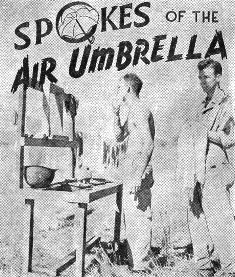 Two Ordnance men with the "Burma Peacocks" go through their morning ablutions in the open air. Pvt. Howard Williamson
of Washington Court House, O., takes care of his stubble while Cpl. Jack Wallington of Mansfield, O., has just finished
washing in a steel helmet. Life in the great open spaces of Burma.
Two Ordnance men with the "Burma Peacocks" go through their morning ablutions in the open air. Pvt. Howard Williamson
of Washington Court House, O., takes care of his stubble while Cpl. Jack Wallington of Mansfield, O., has just finished
washing in a steel helmet. Life in the great open spaces of Burma.
|
Umbrellas have spokes in them, to keep the canopy up there, and Air Umbrellas have Air Groups.
When the war started, the Air Service Group idea was so new that many army ground outfits as well as tactical air squadrons thought these compact little "task forces" of the AAF meant "service troops" such as used by the Wehrmacht and the Jap Imperial Army divisions to do the box bucking and general dirty work back on the line of communications.
Gen. H. H. Arnold's air staff had a different idea, which was to take the elements of a thorough-going air depot, like the one at San Antonio or Sacremento or Middleton, Pa., and streamline those work elements to be mobile, to go anywhere and do anything needed in the way of repair, supply, communications and housekeeping by the fighters, bombers, attackers and transporters.
Today you'll see one of these task forces of the Infantry in the Army Air Forces, now staked out in the tea gardens of the Assam Valley, after having shown their battle discipline at Myitkyina in support of fighters and bombers of the 10th Air Force.
INTO ACTION
The "Global Planesmen" went into action in Burma after Merrill's Marauders had captured the airstrip of Myitkyina and the town, two miles beyond, remained in Jap hands. This was during the monsoon season - May to August. Col. Andrew L. Castleman (now returned on rotation) had led his Air Service Group from Ogden, Utah, to Scotland to England to North Africa on D-Day to Tunisia to Sicily to Italy to Eqypt to Burma.
Picked to releive the globetrotters at Mytikyina prior to the fall of the town was the "Burma Peacocks" group, then commanded by Col. William S. Pecock, Jr., Detroiter who has led a charmed life in the AAF. The "Peacocks" went direct from Tennessee maneuvers to India and dug in at a little town on the Brahmaputra River.
They got their first taste of adjacent war when the Japs "invaded" India over the Manipur-Kohima Road and the group stood ready to support the British 33rd Corps of the 14th Army. Later the men made several noteworthy rescues with search missions, as reported in the Roundup.
One group in Bengal drew the assignment of backing Col. Philip Cochran's Air Commando project; another went into the supply business, being detailed to the Assam Air Depot, which stores, issues, crates, and monitors the aircraft supply of China; another organization established quarters near the dispersal revetments of the Assam where the China transport airplanes of ATC were given Third and Fourth Echelon, or medium-heavy and heavy, repair and maintenance.
Further back down the LOC an Air Service Group took over vital work in connection with movement of gasoline, oil, serial ordnance, and miscellaneous supplies required by the tactical air squadron. Several outfits arrived in Asia, earmarked for the famous XX Bomber Command, where they entered as aircraft specialists. And some outfits provided battle-wise, long-experienced squadrons for the Fourth Echelon air depots in the rear areas which perform no less an important job in rebuilding airplane engines, fuselages, and erecting airplanes that arrive in cut-apart pieces.
CASE OF TUTON
It's difficult to find a "typical soldier" of an ASC group because their duties are either "a little of everything" of they are highly specialized to fit the mission of the outfit. For instance, consider the case of Sgt. Jack Tuton of Chelsea, Mass., who was knocking out prosaic record pictures for the maintenance division of a group in Assam, when the lightning struck.
Cochran needed some daring photo recon men to get the low-down on the Jap-infested jungle and paddy near the future boxes that were destined to be set apart with barbed wire by the British Chindits of Gen. Lentaigne. Jack was boosted into the colorful Air Commando operation overnight, and along with his buddies, Cpl. Richard M. Weir, Cpl. Eli Porter of New York City, Cpl. Edwin P. Padykula of Chicopee Falls, Mass., and Pvt. Carl Jensen, of Gary, Ind., he scoured the skies high above Burma, taking pictures in speedy B-25's.
When the commando mission was over, time lagged for Tuton in regular jobs and he managed to get into the Burma reclamation and salvage projects being handled by a detachment of the "Burma Peacocks." One of these took him behind the Jap perimeter again.
A similar quick transformation from prosaic truck driving to front line combat happened to Pfc. Jack Lovelace of Congress, N.Y. His station had been near Delhi and he had beefed to his sergeant about lack of action. The call came for ASC men to accompany glider-borne engineering equipment into Burma, and the next thing Jack knew he was sitting in the grass of a Bengal plain listening to the incomparable Cochran brief the mission that was to put a new pattern for war into the military textbooks.
Lovelace rode into Burma one dawn with his friend Charlie Fischer of Coschocton, O., as "passengers" with a glider pilot and his flight officer co-pilot. The glider almost arrived intact, but took a hail of Jap bullets which cut the controls. The heavy craft nosed down and Jack and Charlie came to consciousness on the ground, outside the crash. Pilot and co-pilot had been killed under the impact of a heavy bulldozer.
For two days the men did what they could to help other glider-borne airstrip builders, and when the job was eventually finished under Jap shellfire and the Troop Carrier Command flew in C-47's with fighting troops, the two were evacuated with the other brave youngsters of the aviation engineers.
ANOTHER TYPE
Exploits of this character were matched by another kind of courage, as shown by S/Sgt. Edward R. Dillen of Cleveland, Ohio. Dillen arrived in India in the spring of 1942, with the first Air Service Command outfit to try to conquer the alternating monsoon and dust storms, in a land that lacked greatly in modern machinery or in mechanics with specialized skills.
At the Agra site of the future big air depot, an emergency existed for certain airplane parts and no foundry could be located to get the work done. Dillen made a workable molding sand out of G.I. molasses and river sand; created the crucible and bellows out of stray materials and combed the salvage for metal. In a short time he was turning out the needed parts.
Months would have elapsed before shipment of similar parts could arrive from the United States. The Japs at that time were periously close to the invasion borders of India, and airfields had been bombed.
Improvisation in time of emergencies came to characterize the men of all squadrons in the Air Service Groups. Mostly, the ability to overleap obstacles had been born of equipment shortage, and when better equipment did arrive, the men kept up the tradition.
To show the handicaps the task forces have surmounted, the first Agra outfit left San Antonio's Duncan Field as soon after Pearl Harbor as could be managed and the officers themselves knew but part of what their eventual duties would be. They arrived in Karachi in the Spring and then possessed one small wheezy airplane with which to reconnoiter all of India.
Their equipment was shamefully inadequate to the mission of establishing a ground support for the few tactical squadrons that had been flown in to stem the Jap tide. They were technically known as an "air depot group," that is, a future air depot on the march. Today their hard work shows itself in a permanent Agra Air Depot which can perform the most intricate of fourth echelon airplane repair, and if need be, could build an airplane in entirety from the stock of parts it carries.
A few of the Agra pioneers are: M/Sgt. William M. Johnston of Johnstown, Pa.; M/Sgt. James M. Boyd of Randerbrook Ranch, Colo.; M/Sgt. Dale K. George of Altoona, Kans.; Sgt. James H. Trussel of Ferris, Tex.; T/Sgt. Harry H. Hughes of Long Beach, Calif.
AIR SUPPORT
Men like Dillen and Johnston and Boyd and George are duplicated hundreds of times in Air Service Groups, for the structure of the task force comprises in addition to squadrons of supply and service, the attached Army Air Forces versions of companies of Signal Corps, Quartermaster, Ordnance, Chemical Warfare Service, Finance, Medical and Chaplains. Each unit integrated into the Air Service Group under the leadership of the Headquarters Squadron, lives and breathes "air support," and in time learns short cuts that amazingly speed the process of providing service, communication, aerial, ordnance, food and other housekeeping items for those touch-and-go tactical and transport outfits that are primarily concerned with flying their war and not managing it on the ground.
However, though ground work is the mission, a fine sprinkling of flying personnel operate with an Air Service Group. The commanding officer and his key divisional chiefs are often men with silver wings over their hearts. The airplanes that are repaired must be test-flown before being turned back to the "owners"; detachments must be serviced by air in odd parts of the jungle or plains. Several of them have logged more than 700 hours in this Theater in test-flight work and have been checked out in more than 30 different airplane types, from a peashooter fighter to a bulky transport.
 Cpl. J. C. Hamilton, left, of the Royal Engineers, met a former neighbor in S/Sgt. Paul Heinerich of Philadelphia, right. Both used to live in Frankfurt, Pa. Heinerich is an ATC-ICD base while the Britisher is stationed nearby.
Cpl. J. C. Hamilton, left, of the Royal Engineers, met a former neighbor in S/Sgt. Paul Heinerich of Philadelphia, right. Both used to live in Frankfurt, Pa. Heinerich is an ATC-ICD base while the Britisher is stationed nearby.
|
PURPLE HEART
The "Burma Peacocks" outfit, now headed by Col. Marvin Sledge, has the "Biggest Little Airline in the World," a lone UC-64 light-cargo ship, buzzing over the teak forests of Burma with mail and freight for the ASC detachments. S/Sgt. Chester O. Crocker of Troy, Ala., and Sgt. Clifford F. Baumgart of Humphrey, Nebr., are the mechanics who keep the ship in shape and take turns at being "crew." Recently a Jap bullet landed smack in the middle of the rabbit insignia on the ship's cowling, and the lads in feigned seriousness, requested a Purple Heart for the painted mascot.
Two more lieutenants and the incomparable Chief Warrant Officer "Bring 'Em Back Alive" Carr of the same "Burma Peacocks" outfit, vied with the flier for honors during that same fortnight, however, for they captured Jap prisoners during their jungle travels. They were Lt. Jack M. Gober of Houston, Tex., and Lt. Chas S. Samples of Barberton, O. All in a day's work, but slightly off the routine of a so-called air support job.
Samples declared that the capture was completely secondary to the fun of trying to pot a 20-foot python which slithered through a clearing next to the river and plunged into the Irrawaddy. The snake's broken field running was exactly through an area being cleared for the group quarters.
SIX CANDIDATES
When the "Global Planesmen" were relieved, they had six candidates for Purple Hearts in the group. This kind of rugged weather was tough war, but after a fashion, child's play for them because they had received their baptism of Axis fire long ago. On Nov. 7, 1942, they had landed at Arzew, near Oran, behind the Rangers and taken over a Vichy French airfield under a rain of bombs and bulletts. There, the first war chore had been the de-fusing of a quantity of aerial torpedoes big enough to sink the whole British and American fleets if accurately applied by the French fliers.
Yet all is not action and foxholes, of course. "War is waiting" and an Air Service Group gets a share of waiting ebery now and then. In certain remote spots of India there have been outfits assigned to routine repair and supply jobs of a type that gave the men chances to hunt tigers and scout the mountains of the Assam-Tibet border on their furloughs.
Thus with a dash of the AAF flying personnel's color, with a bit of the Infantry's taciturnity and self-effacement, with a touch of the Quartermaster's flair for producing supplies where logic says they can't be had and with the spirit of the former American kid who took used car lot junk and rebuilt it into a cut-down beauty with a squirrel tail on the radiator, the men of these Air Service Groups carve out their niche in the military world. Their structure is as new as television, yet it is working like a good old-fashioned turnip watch.
The grey-haired wonders of Washington fashioned a neat blueprint for spokes in the Air Umbrellas.
STILWELL SAYS G.I.'S FIGHT TO GET HOME
NEW YORK - Gen. Joseph Stilwell, Army Ground Forces Commander, told a Red Cross luncheon here this week, "The American G.I. is really fighting because he wants to get his job done and get back home."
"You would never again miss your regular visit to a Red Cross blood center if you could see just one badly wounded man saved by this wonderful stuff," added Stilwell.

|
Pvt. Richard E. Khoury, telephone operator for the 12th Bombardment Group, 10th Air Force, boasts "more pin-up pictures than Higgins." (It should be explained that "Higgins" is a mythical character dreamed up by the Earthquakers, who represents the ultimate in everything.) Khoury has 385 of the prettiest plastered on the office walls and appeals for more, "the less clothes, the better."
Members of the 1328th AAFBU up in Assam recently celebrated the opening of their new and well-stocked Post Exchange, described as strictly Stateside.
With an eye on the post-war world, enlisted men of an Air Service Group at APO 487 are now attending a Basha University, founded by Information and Education Officer Lt. Chris Dariotis. Bookeeping, accounting, automotive mechanics, a special course in Hindustani and many technical courses are included in the curriculum, all without cost to the G.I.
Four officers and six enlisted men of the 1347th AAFBU experienced something different in duck-hunting recently when a neighboring Indian Khan threw open his game preserve for their use. All of the Yank nimrods did their shooting from the backs of six elephants. Total bag, 50 ducks.
GRAESE'S MESS HAS BEST BURMA CHOW
By S/SGT. EDGAR LAYTHA Roundup Chow Wallah
GEN. SULTAN'S HQ., NORTH BURMA - Wherever I wander off along the trail of G.I. stories in Burma a growing nostalgia for S/Sgt. John Graese's magic cooking arts always hastens my return to the headquarters of the Northern Combat Area Command.
Graese has made chow history in the brambles. Officers actually complained that food in the enlisted men's mess was better than their own. Since the brass moaned about their inferior vitamins, the sergeant has had to draw personally the rations for both mess halls and see to it that there is no more discrimination on behalf of the jungle-rationless enlisted man.
ALLURING OFFERS
Graese was given alluring offers to concentrate on the officers' mess but declined unless he could also cook for his fellow comrades in the ranks.
The culinary case history of Graese throws a torch on the eternal chow problem. A good soldier has proved that mess sergeants are responsible for the quality of the mess hall food. That home cooking is possible in any mess hall, however large.
Graese thinks an ideal mess sergeant should be a professional whose cooking has stood the test of public opinion in civilian life. Jack, for instance, cooked for a living for 13 years before he enlisted. He was head chef in a large Milwaukee restaurant where steaks and barbeque spare ribs were his specialties.
16 COOKS
Most of the 16 cooks who work under Graese are good professionals. S/Sgt. F. D. Zechmeister of Detroit, Sgt. Bruce Swindle from Tennessee, Sgt. Gilbert Rodriquez from the Waldorf, and Sgt. Frank Zeloth, Jack's former schoolmate, are artists in the profession.
Cooks with the ambition of the above have the gratitude of their fellow soldiers. Jack, himself, bosses three mess halls and scarcely a day goes by without thanks from his many fans. Brig. Gen. Joe Cannon, for example, ventures daily into the kitchen and sees that the cooks have everything they desire. During the last campaign many theater generals personally complimented Graese. Stilwell at Shingbwiyang, Sultan at Shadazup, Willey at Ledo and Cannon everywhere.
NO EXCUSES
Jack disdains to comment on the constant excuse of mess sergeants that you can't cook invidually for hundreds of men. This has been proved false in Stateside cafeterias and G.I. mess halls here in India and Burma. The feed-and-get-it-over-with attitude results only in perpetual dissatisfaction. The G.I. cook must know a dozen ways to prepare his C rations.
Jack says, "It's all a matter of preparation. Every soldier is entitled to one outstanding meal a day.
|
For example, Graese serves at least one piece of cake or pie every day but he is rarely satisfied with plain cake. He makes shortcakes with fruit salads or other combinations. He serves not only boiled potatoes, but mashed, French fried, home fried and browned. This means extra work, but it is worth it just because of the G.I. reaction.
EXTRA EFFORT
Extra effort is also put into the bread we get with the meals. It's plain, dry-toasted and butter-toasted. You get your choice. And those butter-toasted ones are hot and soft, almost melting in your mouth.
Graese tries to utilize his meat supply for steaks if it is at all possible. What is left of rolled roast he serves as stew. Frankfurters, the problem child, he lets simmer for a long time in a Spanish sauce and serves with potatoes. Or he gives a mixed combination of Wieners, bacon and sauerkraut.
The sergeant's favorite C-ration dish is spaghetti with meatballs Italian style. He learned this dish while helping out a Latin in Manhattan.
NO G.I.'S
Jack's proudest boast is that "no one ever got the G.I.'s at my mess. My cooks are clean, my water is always boiling and clean. We change it even during meals."
Concluding our tribute to soldier-cook graese, let us remember these mess sergeants on the trail. I have met them. They have of course, less to play with than Jack Graese. And a C-ration too has it's limitations. They try hard. But if you happen to be stationed at a place where food doesn't come by parachute, don't let him fool you any more.
If he is good, say thank you. If he isn't, have him transferred to the M.P.'s.
 When the G.I.'s of an Army Airways Communications System outfit sent this picture of blonde "Stephie" Winkler, their pin-up choice, they were cautious... The didn't give her hometown or street address. Too bad, wolves. Well, here's winking at you, Winkie, just the same.
When the G.I.'s of an Army Airways Communications System outfit sent this picture of blonde "Stephie" Winkler, their pin-up choice, they were cautious... The didn't give her hometown or street address. Too bad, wolves. Well, here's winking at you, Winkie, just the same.
|
ATC Longest Water Flight Links
India-Burma With Pacific Areas
CALCUTTA - A new scheduled flight between Calcutta and the pacific Ocean areas, inaugerated by Air Transport Command with the object of providing closer liaison between India-Burma and China Theaters and the headquarters of the U.S. Forces in the Pacific areas, has completed the last link in the military air transportation system which will reach around the world.
Brig. Gen. William H. Tunner, commanding general of India-China Division, said weekly scheduled flights will be made between India and the Netherlands East Indies via Australia, with connecting flights to the Philippine command of Gen. Douglas MacArthur and the islands under Adm. Chester W. Nimitz.
The first scheduled flight arrived last week in India after a record-breaking flight from Australia to Ceylon. This leg of the flight is the longest scheduled over-water hop in the ATC globe-girding system. It exceeds by nearly 1,000 miles the previous longest water jump from San Francisco to Honolulu.
Piloted by Capt. Warren E. Dean, Augusta, Ill., the C-54 Douglas Skymaster averaged 204 miles an hour in the initial flight.
This new scheduled flight makes it possible for military and civilian personnel to circumnavigate the globe on a single ticket. An around-the-world flight originating in Washington would take the traveler to Stepenville, Newfoundland; the Azores; Casablanca and cairo in Africa; Karachi and Calcutta in India; Columbo, Ceylon; Australia; Netherlands East Indies; the Philippines, Guam, Honolulu and San Francisco.
K.P. Made Easy By Spud Peeler
HQS., TENTH AIR FORCE, BURMA - Add to the list of unofficial items on the table of equipment a potato-peeler whipped up from spare parts by Sgt. Pedro Regalado, first cook of an 80th Fighter Group squadron.
Spuds, when the outfit can get them, are tossed into an empty oil drum containing a circular aluminum sheet punctured with many jagged holes. As water flows in from elevated tanks, a device rigged from a small gasoline engine, Austin differential and a driveshaft revolves the drum and the ragged holes buff the potatoes' jackets.
Forty-year-old Regalado, former interior decorator with Paramount Pictures, is probably the most popular cook with his K.P.'s in the I-B Theater, but others in the kitchen vicinity say the device makes a cement mixer sound like a miracle of noiseless operation.
TRAINMOBILE TOURS ASSAM
ASSAM - Military Railway Service boys hereabouts look forward now and then to the arrival of the American Red Cross "Trainmobile," an attractive day room on wheels, which tours the 800-mile Assam rail circuit, attached to regular trains, on a 25-day schedule which includes two stops each at 15 different stations.
The car, built by MRS personnel from plans worked out by Brig. Gen. Paul D. Yount and Frank Tweedy, ARC supervisor for northeast India, was furnished by Red Cross workers Virginia Keadle and Maxine Robertson, a major problem considering the meager shopping facilities of Assam.
During overnight stops while the Trainmobile is sidetracked at the various stations, G.I. railroaders come aboard to see movies (obtained from Special Services), enjoy cookies and doughnuts baked by the girls, and lounge on the comfortably-cushioned seats.
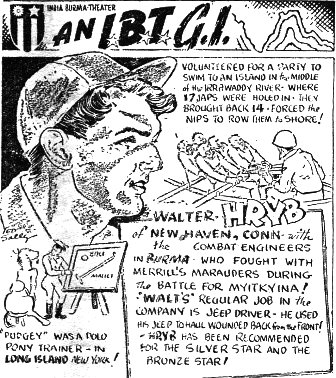
|
Mail Cans Save Time, Trouble
1347TH AAFBU, INDIA - Every mail-sweating Yank who has ever suffered through a lengthy mail call while the orderly stuttered and gagged over names like Vladyzkinopoulos will laud the invention of Capt. Leslie Byron, CO of this ATC unit - a squadron mailbox with an individual pigeonhole for each man.
Pvts. William Brooklins and Sidney Ross constructed the new mailrack, using old ration cans with the ends knocked out, plus salvaged wire and nails and some pieces of wood and bamboo. Each man's name is painted beneath his individual receptacle and covered with Scotch tape against weathering.
Space is provided below the rows of "mail cans" for parcel mail, and a special "mail chute." also built from ration cans, is set up out front for outgoing letters.
Now every man hoping for a sugar report from home need only go by and check his mailbox. Capt. George Lusk, P. and T. officer, estimated the new system saves many manhours every day.
ATC CG AWARDED OAK LEAF TO AM
CALCUTTA - Brig. Gen. William H. Tunner, Commanding General of the India-China Division of the Air Transport Command, was awarded the Oak Leaf Cluster to the Air Medal at Air Force headquarters here.
Tunner, as a command pilot. participated in over 150 flight hours over India and China, including enemy held and adjacent territory, during the period from September 1944 through January of this year.
The award was presented by Maj. Gen. George E. Stratemeyer, Commanding General of the AAF in the India-Burma Theater.
14th Army Hits Near Oil Fields Lost in 1942
The British 14th Army is at the gates of the oil fields of Burma, where extensive demolitions were carried out during the retreat in 1942, and whose sites have been under almost continuous bombardment by Allied planes of Eastern Air Command for the past year.
The Irrawaddy area, where the 14th units are now operating, was the source of most of Burma's oil which supplied one and a quarter million tons of the british Empire petroleum annually.
The main oil production centers were Yenandyaung (130 miles southwest of Mandalay), Chauk (110 miles southwest of Mandalay), Yenangyat and Lanywa.
RIVER CRAFT
The oil from these fields was carried down to refineries near Rangoon, one company using a pipeline and the other two river craft.
As the Japs advanced in 1942, the Rangoon refineries were set afire. The pumping stations to the fields were destroyed and the pipeline plugged with cement. Most of the plants in the oil fields were put out of action.
The Japs began work on putting the fields back in use in 1943. Activity was noticed at Yenangyat and Chauk among others. The pipeline was put back in operation.
PIPELINE BROKEN
Allied air operations hit continuously at these operations. The American Air Force rendered the Chauk plant unserviceable in an attack in 1944, while British Beaufighters broke the pipeline in five places.
The Japs substituted river craft for the pipeline, but their river craft were continuously strafed.
Now the British Army is regaining the rich oil territory. And Jap air power is impotent to strike against British occupation with the Allies having control of the sky over Burma.
|
AIRMEN RESCUED FROM NO MAN'S LAND
HQS., 10TH AIR FORCE, BURMA - Escape from death near the Jap forward lines in Burma was effected by a Combat Cargo crew of the 10th Air Force recently when an air-dropped supply case tore off a stabilizer of the C-47, causing a crash landing in the middle of "no man's land" during a battle.
Unable to climb because the elevator control was smashed, Lt. harley hanson, pilot, Washington Island, Wis., and Lt. James Kolb, co-pilot, Puaki, Wis., circled the big plane in the valley where the accident occured.
The mountains surrounding the valley towered 2,500 feet above the plane. Escape by air with the damaged plane was obviously impossible.
Looking for a place that would ease the impact of a crash landing. Hanson spotted a rice paddy. It was set in terraces on a mountainside with one of the upper levels having a hay-stack the target for his landing.
Cutting the power, he let the C-47 down, losing altitude rapidly. Cpl. Gabriel V. Markantonio, 20, radio operator of Riverview Circle, Wayland, mass., and several unidentified cargo kickers, braced themselves for the crash. The plane narrowly missed plunging into an embankment, skidding along a flat surface of the rice paddy into the hay stack as the tail rose high in the air.
All crawled out of the wrecked ship to discover they had landed in :no man's land." Bursting shells and the chatter of machine guns could be heard nearby. To prevent any possibility of the plane falling into Jap hands, the crew set the plane on fire and withdrew to a safe distance.
Fifteen minutes later an American Infantry patrol located the airmen and led them to safety. They learned that an artillery duel was in progress between the Japs and the Americans on opposing mountain sides only a short distance from their crashed plane.
After spending a night at the forward medical aid station in the jungle, the aircrew members returned to their base via "jeep" planes. Their final view of the scene was the tail of their wrecked transport still upended and smoking from the fire.
G.I. 50 Years Old, Still Going Strong
HQ., 10TH AIR FORCE, BURMA - Twenty-six years ago Sgt. Martin L. Helpman was a pilot-sergeant for the Army, flying observation planes over the mountains of Oregon and later over famed Corregidor in the Philippines.
Today the 50-year-old sergeant has temporarily settled down on the edge of the jungle in Northern Burma as a radio operator for a Signal Aviation company of the 10th Air Force.
Helpman has had few dull years in his 23 years in the Army - more than four years of these flying the World War I glamour plane, the Jenny. He held a reserve commission as a second lieutenant for 15 years, but in October 1942, when the commission had been dropped for five years, he enlisted as a private at Stockton Field, Calif. He stayed at Stockton for two years as an instructor in communications.
This is the second time that Helpman has been in Asia. The first trip was to Siberia in November, 1919, while taking a circuitous route to the Philippines.
|
PONY EXPRESS IN 1945 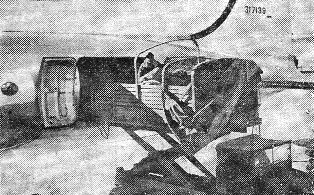 The body of this truck is jacked straight into the air instead of tilted. It enables the cargo to be loaded onto a high-fuselage plane with ease.
The body of this truck is jacked straight into the air instead of tilted. It enables the cargo to be loaded onto a high-fuselage plane with ease.
|
ATC Pilot Learns Altitude Trick
1330TH AAFBU, ICD ATC, ASSAM - Lts. B. S. Gibson and O. E. Scott, pilots of a four-engine transport returning from China recently, whipped up a little landing procedure all their own, taught at no recognized flying school, losing 11,000 feet altitude on final approach.
With No. 4 engine out and prop frozen in an unfeathered position, the Hump jumpers decided to sit down at a small field having a 5,000-foot elevation, with an inconvenient mountain adjacent. But when Gibson levelled of on final approach, the altimeter showed 16,000 and no chance to go around again with one prop dragging him down.
He called for "gear down, full flaps, power off, and anchor thrown out." The airplane dropped like a streamlined brick. Scott applied 10 inches manifold pressure to break the rapid descent and put the power on the two inboard engines. Just before touching ground he threw the three good engines into high RPM, mixture controls in idle cut-off, and opened all the cowl flaps. Old Betsy stalled in like a helicopter, with a very short landing roll.
Said Gibson of their cockpit manuevers, "The effect was amazing."
Yank Engineers Aid 36th British In Burma Drive
HQ., 36TH DIVISION, BURMA - As varied in uniform as their daily chores, the fighting advance detachment of a company of U.S. Airborne Engineers looks much like any construction crew in the States. In sweating through the jungles and hills of northern Burma with the British 36th Division, these Americans do a job that would drive a Stateside construction boss off the deep end of the pier.
Their mission is to convert paddy fields and scrub-land into air-strips for the mercy-bound liaison planes which evacuate wounded from otherwise inaccessible areas. They also construct bigger landing fields for combat cargo C-47's of the 10th Air Force.
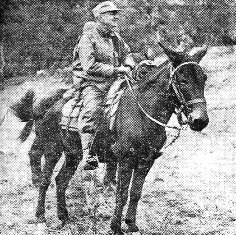 When India-Burma Theater Commander, Lt. Gen. Dan I. Sultan refused a well-trained horse and mounted a mule to ride
up to the front to bestow decorations on the Mars Task Force, the mule experts were betting Gen. Dan would take a
header. But he surprised the G.I.'s by getting there without mishap.
When India-Burma Theater Commander, Lt. Gen. Dan I. Sultan refused a well-trained horse and mounted a mule to ride
up to the front to bestow decorations on the Mars Task Force, the mule experts were betting Gen. Dan would take a
header. But he surprised the G.I.'s by getting there without mishap.
|
ONE POWER GRADE
The Engineers accomplish this work with the help of one power grader and one airborne tractor. Often they have to fight before they work. Forging ahead to build strips for advancing troops, they run the risk of sniper fire and enemy patrol action.
They were the first white men in the Indaw airfield area in more than two years. And at their most recent strip, a few thousand yards behind the front, they were fired upon while surveying the site. So far, however, they have suffered only one casualty from enemy action.
Working under Lt. J. A. Mullaney, a tough but popular Irishman, the advance detachment of the company normally build a strip in three days; puts up a control tower in four hours. Then they operate the field until the regular control crew arrives.
14TH MONTH
Most of the men of the company, which is commanded by Capt. N. Giordano, a New Jersey engineer, have been overseas at least 14 months. Their first big job was a B-29 base in eastern India. Then came Myitkyina and jungle strips in the Burma railway corridor towns of Mawlu, Indaw, Katha and other villages farther south.
Considerable praise has been bestowed on the Engineers by Maj. Gen. F. W. Festing, commanding the British 36th Division, who credits them and other U.S. Air Force units with a major share of the marked success of his British and Indian troops.
The advance crew of the company under Mullaney includes S/Sgt. Frank B. Brabowski; Sgt. Ray H. Sandler; T/5's Paul LaBelle, Surley Thomas, and Edgar A. Smith and Pfcs. James Watkins, Milton C. Copeland, Anthony J. Pellucci, Vincent J. Carrasco, Earl W. Haywood and Paul C. Martin.
|
Stilwell Wants 'Expert' Medal
WASHINGTON - (ANS-UP) - Gen. Joseph W. Stilwell has about every decoration there is in the book, although he seldom wears them.
But "Uncle Joe" has a yearning look in his eye when decorations are mentioned - for he lacks the one he desires most.
He mentioned it to a friend after being presented with the Oak Leaf Cluster to the DSC and the Legion of Merit by Secretary of War Henry L. Stimson.
"You know there is just one medal I would like to have and to wear, but I've never been able to get it," growled Uncle Joe.
"What's that?" asked the friend.
"Expert rifleman," answered Stilwell.
In the photo at left, Secretary of War Henry L. Stmson awards the Legion of Merit, DSM and Oak Leaf Cluster to Gen. Joseph W. Stilwell, head of the Army Ground Forces and former CBI chief. Stilwell was honored for "his courage, superior leadership and indomitable spirit."
The Roundup is a weekly newspaper of the United States Forces, published by and for the men in Burma and India, from news and pictures supplied by staff members, soldier correspondents, Army News Service, and United Press. The Roundup is published Thursday of each week and is printed by The Statesman in New Delhi and Calcutta, India. Editorial matter should be sent directly to Capt. Floyd Walter, Hq., U.S.F., I.B.T., New Delhi, India, and should arrive not later than Sunday in order to make that week's issue. Pictures must arrive by Saturday and must be negatives or enlargements. Stories should contain full name and organization of sender. Complaints about circulation should be sent directly to Lt. S. R. Rose, Hq., U.S.F., I.B.T., New Delhi, India. Units on the mailing list should make notification of any major change in personnel strength or any change of APO.

March 8, 1945
Original issue of Roundup shared by CBI veteran Howard Sherman.
Copyright © 2006 Carl Warren Weidenburner
TOP OF PAGE PRINT THIS PAGE ABOUT THIS PAGE SEND COMMENTS
PREVIOUS ISSUE CLOSE THIS WINDOW NEXT ISSUE


 Happy Holiday, USO troupe 361, visited the Seventh Bomb Base and here the boys are gazing at their ideal briefing.
Who said it couldn't happen in India-Burma?
Happy Holiday, USO troupe 361, visited the Seventh Bomb Base and here the boys are gazing at their ideal briefing.
Who said it couldn't happen in India-Burma?
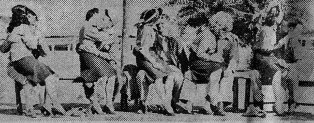 Here the boys get their reward after a mission, Or at least this is what they would like after every mission.
Here the boys get their reward after a mission, Or at least this is what they would like after every mission.
